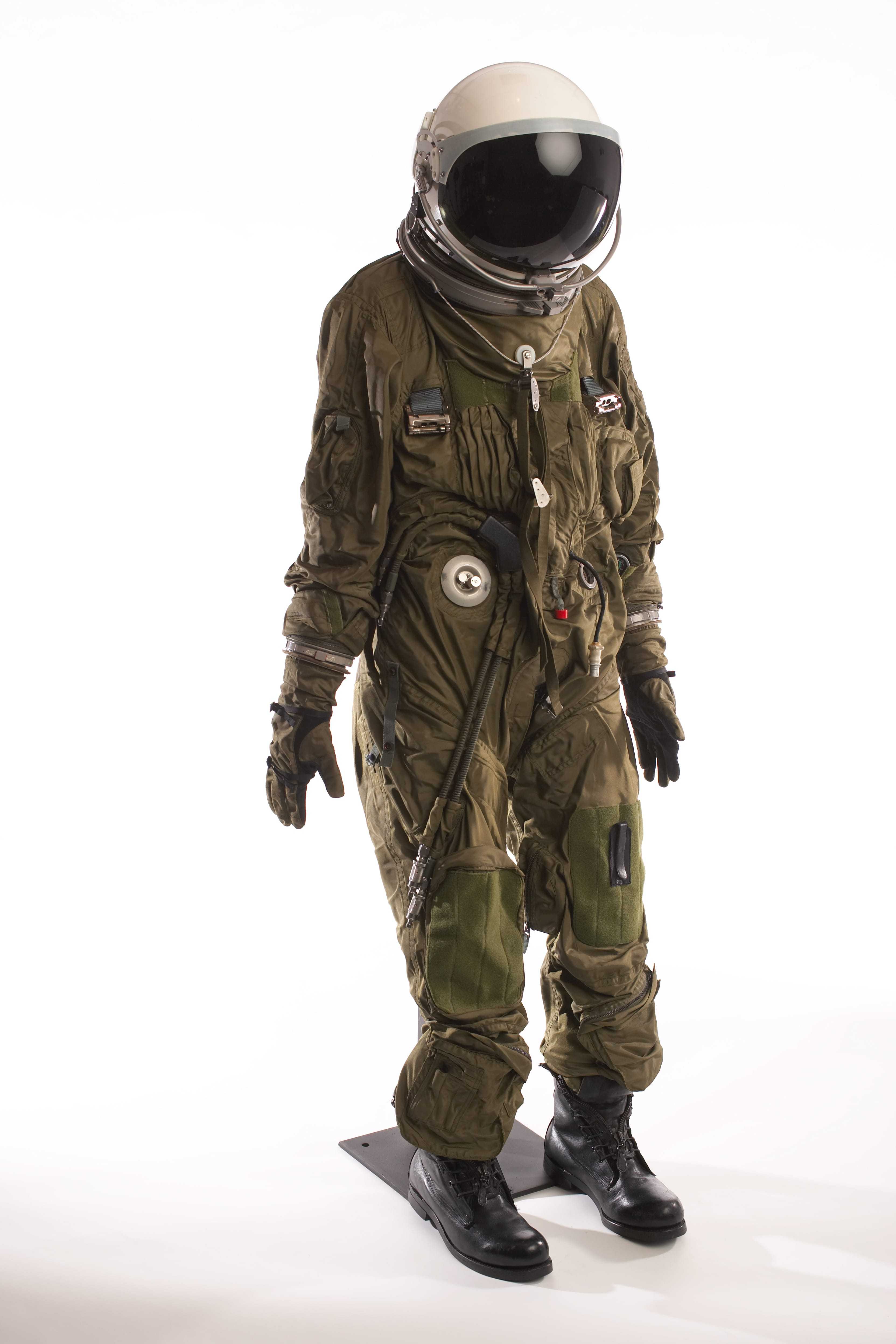Artifact Details

U-2 planes could fly at 70,000 feet, so pilots had to wear this pressure suit to protect them.
Suit – This is an S-1010 pressure suit for a U-2R plane. High-altitude pilots wear pressure suits as protection from cockpit depressurization. At altitudes above 63,000 feet without artificial air pressure, human blood and other fluids boil. In addition to preventing this, pressure suits also protect pilots from low temperatures at high altitudes. The temperature at U-2 mission altitudes is about minus 70 degrees Fahrenheit. If the pilot had to eject, he would free fall for two to three minutes before parachute deployment. The suit provides flotation for a water landing, as well.
Helmet – A coated-fabric face barrier inside this U-2 helmet divides the oxygen supply into two sections. One region covers the eyes, nose, mouth, and chin; the other compartment houses the rest of the head and is linked to the air in the interior of the suit. The barrier fits smoothly to the skin across the forehead, down the side of the face in front of the ears, and under the chin to make an airtight seal. The pilot’s breath passes from one region to the other by means of a one-way exhalation valve near the right cheek.
To close the visor, a lever is pulled to lower it and force it against the gasket on the shell. Then, liquid and paste food can be ingested by the pilot through the feeding port located in the front of the helmet on the lever latch. The visor contains a transparent resistive heater to keep it clear of condensation.
Artifact Specs
27 cm x 27 cm x 26.5 cm
(L x W x H)
Additional Photos

Video
In the early 1950s, recognizing that the United States knew dangerously little about the Soviet Union, President Dwight Eisenhower charged the CIA with developing an overhead collection program capable of closing critical intelligence gaps.
The result was the Lockheed U-2, a remarkable powered glider that could fly at 70,000 feet, had a range of 2,950 miles, and carried the finest camera lenses in the world.
Between 1956 and 1960, covert U-2 reconnaissance missions enjoyed extraordinary success, yielding photographs of strategic targets across Eastern Europe and the Soviet Union.
While the Soviets rigorously tracked these overflights, their missiles and fighters could not reach high enough to prevent them, and they were reduced to protesting and pushing their scientists for technological breakthroughs.
Finally, on May 1st 1960, a Soviet SA-2 brought down a U-2 photographing ICBM sites near the city of Sverdlovsk.
Unknown to the United States the pilot, former Air Force Captain Francis Gary Powers, survived, and the Soviets had recovered his plane.
The United States released an untenable cover story about a weather plane that had wandered off course and claimed that no deliberate attempt to violate Soviet airspace had been made.
Pilot, aircraft, and film in hand, Soviet Premier Nikita Khrushchev launched a propaganda campaign that greatly humiliated the Eisenhower administration.
Khrushchev demanded an apology, and Eisenhower steadfastly refused.
Powers was tried and convicted of espionage.
After serving 18 months of a 10-year sentence, he was exchanged for Rudolf Abel, a Soviet agent serving 30 years in a Federal prison for spying.
Upon his return to the Unites States, Powers faced numerous inquiries, including a formal board convened by CIA.
Despite pressure to find fault with his actions, the board exonerated Powers completely.
He received the Intelligence Star in 1965 and, in 2000, on the 40th anniversary of the U-2 incident, was posthumously awarded the Prisoner of War Medal, the Distinguished Flying Cross, the National Defense Service Medal, and the CIA Director’s Medal for extreme fidelity and extraordinary courage in the line of duty.
Although the CIA’s U-2 program literally crashed in 1960, it produced intelligence that allowed the United States to moderate its responses in the arms race with the Soviets.
Moreover, it yielded an airframe that continues to serve US intelligence efforts today.
Learn More
The CIA and the U-2 Program, 1954-1974
The U-2 Program: The DCI’s Perspective
The U-2 Program: A Russian Officer Remembers
